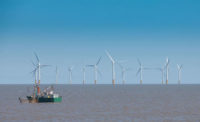Offshore wind is growing quickly as demand for renewables and large-turbine technology progresses.
Europe is today's market leader in the construction of offshore wind farms, generating over 90% of all offshore wind energy worldwide. Europe's dominance in the field is largely the result of the European Union's 2009 directive mandating that 20% of the energy consumed within the EU be generated from renewable sources by 2020.
At present, Europe has 82 operating wind farms in 11 countries, with a total offshore wind capacity of 10,393 MW. Some 3,072 offshore turbines were installed and grid-connected as of July 2015. By 2020, Europe’s offshore wind capacity is forecast to be 23,500 MW, according to Oliver Joy, spokesman for the European Wind Energy Association.
Offshore wind-farm owners benefit from an onshore feed-in tariff, but the “European Commission has urged member states to move toward market-based tendering systems, which are expected to produce cost reductions through competition,” says Joy.
One fundamental attraction of these projects is that offshore winds tend to blow harder and more uniformly than on land, according to the Bureau of Ocean Energy Management, a unit of the U.S. Dept. of the Interior. Because the potential energy generated from wind is proportional to wind speed cubed, increased wind speeds of only a few miles per hour can produce a significantly larger amount of electricity.
All the wind-farm turbines in the accompanying slide show are between 3 MW and 5 MW, but larger ones are on the way.
“Now, we’re looking at 8-plus-MW turbines,” says Santiago Paredes-Pinzon, head of the offshore-wind unit for Ramboll, a Danish engineering firm. "There are research projects looking at 10 MW and even 20 MW. The key here is that the design approach will have to be different. It’s no longer a matter of just scaling things and making them bigger. Controls, aerodynamics and new advances in materials science need to be combined to achieve these goals."
Several large offshore wind farms are currently under construction in Europe. Van Oord is the engineer-procure-construct contractor for the 600-MW Gemini wind farm, located 85 kilometers off the Netherlands coast. The project’s two substations and monopiles for 100 of the 150 turbine foundations had been installed as of September 2015. Construction is expected to be completed by 2017. DONG Energy is building Gode Wind 1 and 2, totaling 584 MW, off the German coast; all 97 monopile foundations had been completed by August 2015, turbine installation is under way, and completion is expected in 2016.
Onshore and offshore wind farms, combined, are currently capable of supplying 10.2% of total European electricity demand, of which offshore can supply 1.1%.
As for the offshore wind-farm market outside Europe, “Asia has started to emerge,” says Paredes-Pinzon. “Ramboll has done detailed design of foundations for a project in China and is actively involved in other Asian countries."
China has three operating offshore wind farms: the 201-MW Chenjiagang Xiangshui Offshore Wind Farm and the 150-MW Longyuan Rudong Intertidal Wind Farm, both located in Jiangsu Province, and the 102-MW Donghai Bridge Wind Farm, located in Shanghai.
Two more large offshore wind farms are under construction in China: CCCC Third Harbor Engineering Co. is erecting turbines for the 50-MW first phase of the 400-MW Longyuan Putian Nanri Island Wind Farm in Fujian Province. The project is expected to be completed by 2019. Work crews started driving piles for the 300-MW Rudong Wind Farm in Jiangsiu Province in June 2015 and expect to complete it in 2018.















Post a comment to this article
Report Abusive Comment